Key Points:
- While the cottonmouth resides in North America only in wet and marshy areas, the rattlesnake can be found in North, Central, and South America in mountains, deserts, and grassy habitats.
- Both cottonmouths and rattlesnakes are pit vipers and hard to tell apart. While cottonmouths have varied patterns on their bodies, the rattlesnake has diamond shaped patterns and the rattle on the end of its tail.
- A cottonmouth wards off predators by emitting a musk from its tail, while a rattlesnake will shake the rattle on its tail.
Both the cottonmouth vs rattlesnake have an extremely venomous bite, but have you ever wondered what differences they may share? Some of these snake species live in the same location and have similar physical characteristics, but how can you learn to tell them apart?
In this article, we will address all of the differences between a cottonmouth snake and a rattlesnake, including their typical behavior and dietary preferences. If you have always wanted to brush up on your snake identification skills, you’re in the right place! Let’s get started and learn about these two vipers now.
Comparing Cottonmouths vs. Rattlesnakes
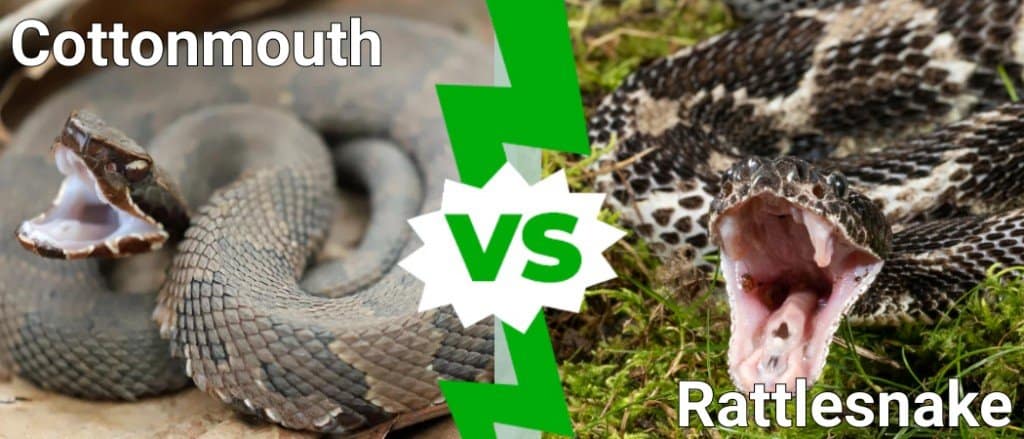
| Category | Cottonmouth | Rattlesnake |
|---|---|---|
| Size | 2-6 feet long | 1-8 feet long |
| Appearance | Black, brown, and olive coloring; distinct thick body and white mouth or gums; large triangle head and alternating color body patterns | Coloring varies based on habitat; triangular head and vertical pupils; raised scales and diamond patterned body. Has a namesake rattle on the end of its tail |
| Location and Habitat | North America only; wetlands, watery habitats, and marshes | North, Central, and South America; mountains, deserts, grassy areas |
| Behavior | Avoids people and has less potent venom compared to rattlesnakes; shakes its tail and emits a musk to ward off predators | Extremely potent bite for humans, but prefers to be left alone; rattles its tail to ward off predators. Changes the times of day it hunts based on the season |
| Diet | Fish, rodents, shrews, frogs, reptiles, birds, insects, and eggs | Rats, mice, lizards, rats, and frogs |
| Lifespan | Less than 10 years | 10-25 years |
Key Differences Between Cottonmouth vs. Rattlesnake
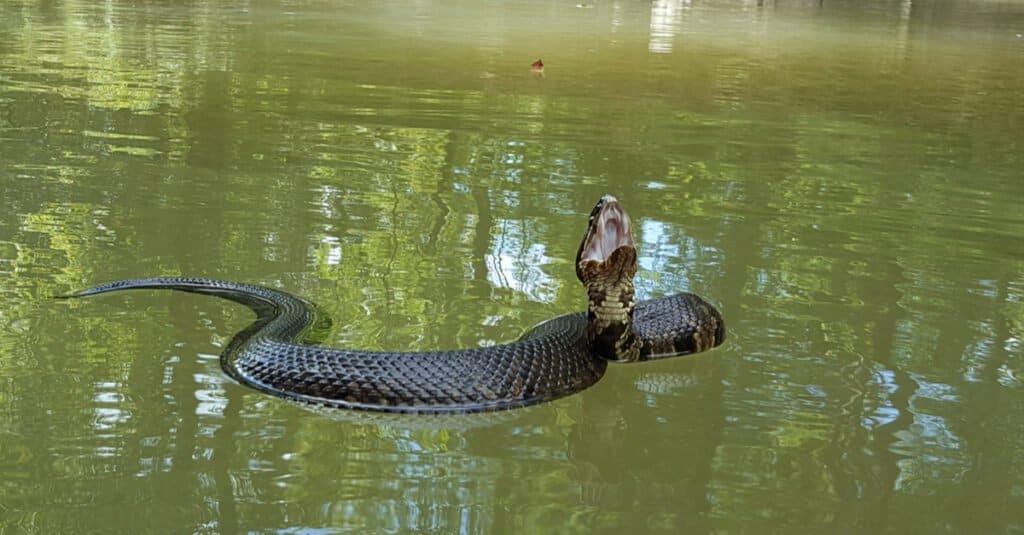
Rattlesnakes swim out of necessity and prefer to be on land, while cottonmouths enjoy living in aquatic environments.
©Seth LaGrange/Shutterstock.com
There are many key differences between a cottonmouth and a rattlesnake. Cottonmouths grow smaller than a wide variety of rattlesnake breeds, but both snakes have equally thick bodies. Rattlesnakes swim out of necessity and prefer to be on land, while cottonmouths enjoy living in aquatic environments. Finally, rattlesnakes have a distinct rattle at the end of their tails, while cottonmouths do not.
Let’s discuss some of these differences in more detail now.
Size and Weight
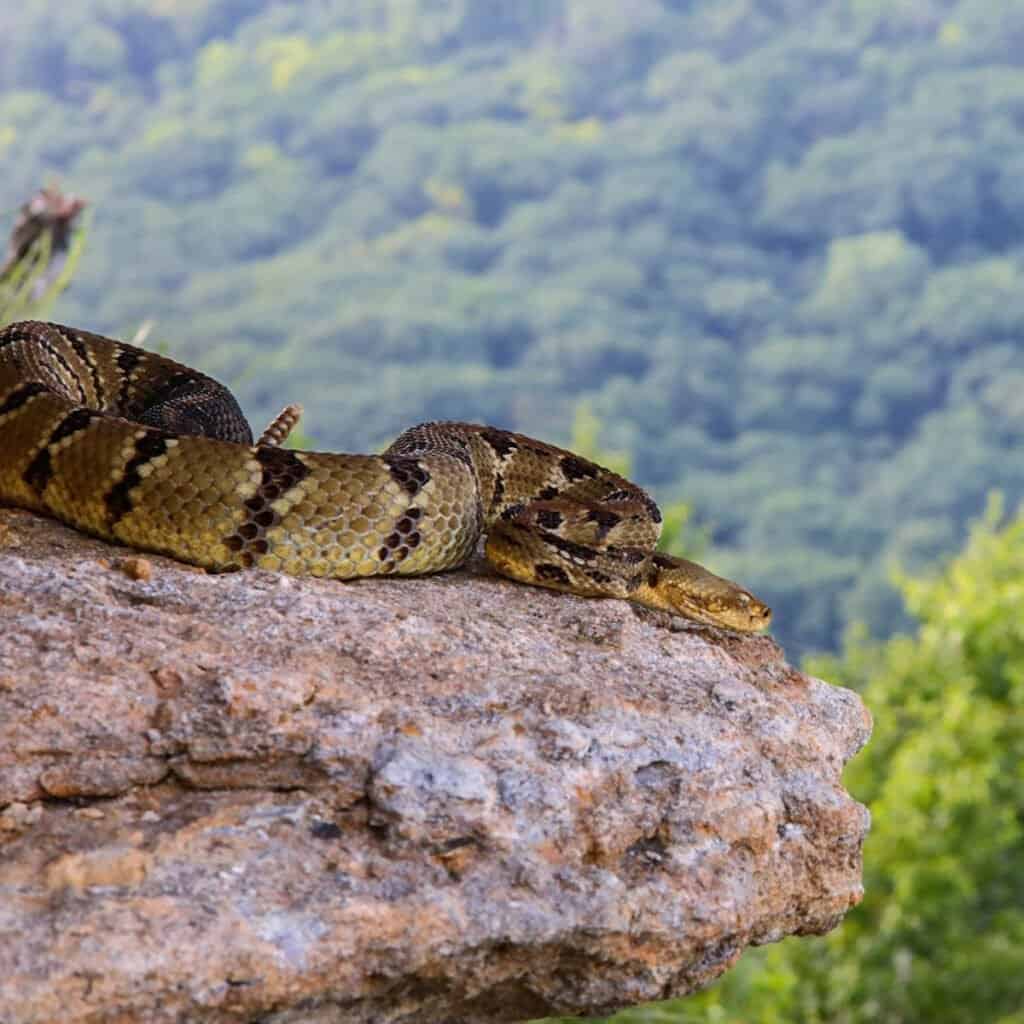
Rattlesnakes grow anywhere from 1 to 8 feet long, while cottonmouths grow 2-6 feet long on average.
©bradenjalexander/Shutterstock.com
A significant difference between a cottonmouth vs rattlesnake is their size and weight. Cottonmouths are smaller than the average rattlesnake, but it also depends on the specific breed or rattlesnake species. For example, rattlesnakes grow anywhere from 1 to 8 feet long, while cottonmouths grow 2-6 feet long on average.
There are certain rattlesnake species that grow much longer than cottonmouths, and vice versa. The Eastern diamondback rattlesnake reaches 10 feet long on occasion, while cottonmouths rarely grow larger than 6 feet. However, some cottonmouths grow larger than certain rattlesnake species, so this isn’t a hard and fast rule.
Location and Habitat Preferences
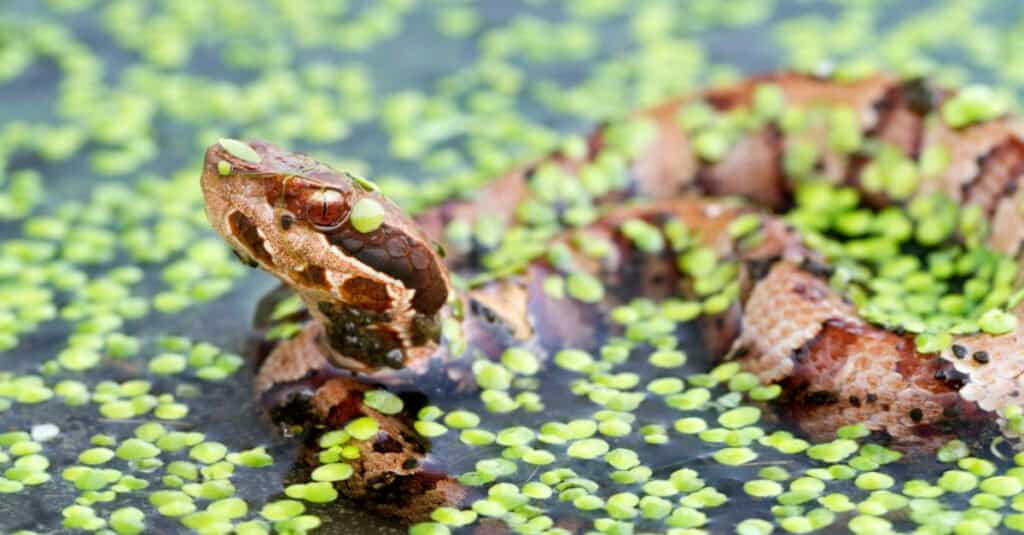
Cottonmouths enjoy swimming in many different aquatic settings.
©Mark_Kostich/Shutterstock.com
Both cottonmouths and rattlesnakes live in North America, specifically the southern United States. This means that you can find both of these snakes in the same habitat or environment, namely Florida. However, cottonmouths are only found in North America, while rattlesnakes are found in North, South, and Central America.
The preferred habitats of these two snakes also differ greatly. Cottonmouths enjoy living in watery or aquatic environments, such as marshes, wetlands, and alongside rivers and ponds. While rattlesnakes may also be found in these locations, they prefer spending their time on land, and in warm, dry climates.
The average rattlesnake lives in arid deserts and warm mountain climates. You can also find rattlesnakes in forested areas or grasslands, much like cottonmouths. However, rattlesnakes only choose to swim out of necessity, while cottonmouths enjoy swimming in many different aquatic settings.
Appearance
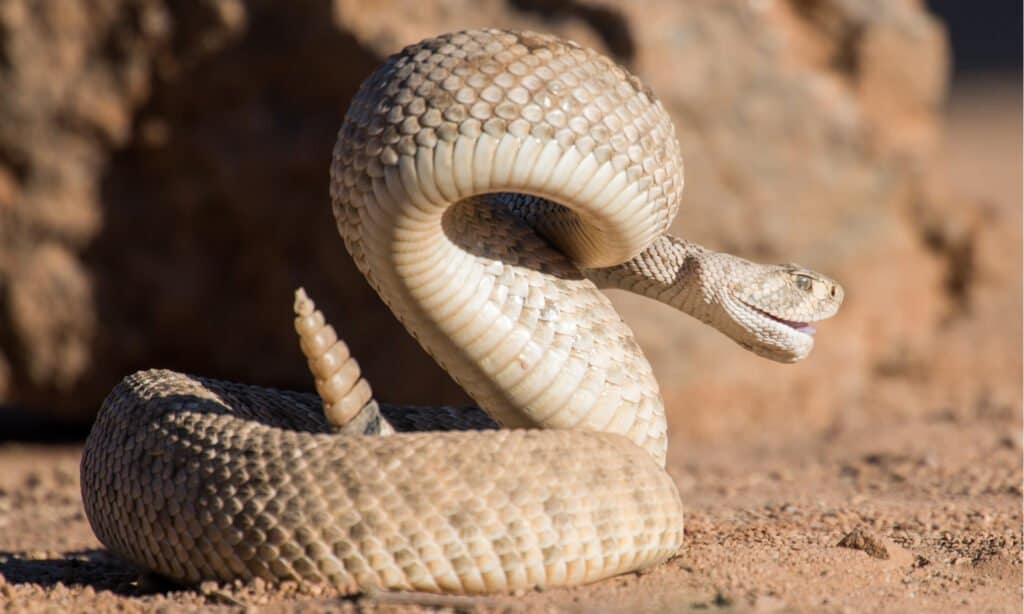
Cottonmouths have patterned bodies in shades of brown or black, while rattlesnakes have a distinct diamond pattern.
©Susan M Snyder/Shutterstock.com
It can be extremely difficult to tell a cottonmouth apart from a rattlesnake. This is why the two snakes are often confused, and for good reason. They are both members of the pit viper family, but there are a few things that you can look out for in order to tell them apart. Let’s discuss some of these differences now.
Cottonmouths have patterned bodies in shades of brown or black, while rattlesnakes have a distinct diamond pattern on their bodies. Rattlesnakes are also found in more colors than cottonmouths, depending on their preferred habitat or location. Desert rattlesnakes have tan or even yellow and peach colored scales, while cottonmouths never have scales in these shades.
Cottonmouths can be easily identified by their bright white mouths, while rattlesnakes do not have white mouths. You can also identify a rattlesnake by its namesake rattle on the end of its tail. Both of these snakes have earned names based on how you can best identify them, so keep these names in mind should you come across a snake while hiking!
Behavior

Rattlesnakes rattle their tails and coil up; cottonmouths mimic a rattlesnake’s rattle and emit a musk to deter predators.
©Creeping Things/Shutterstock.com
Another difference between cottonmouths vs rattlesnakes is their behavior. While both of these snakes prefer to be left alone and only bite when threatened, they exhibit different responses if they feel cornered or threatened. For example, rattlesnakes rattle their tails and coil up, while cottonmouths mimic a rattlesnake’s rattle and emit a musk that deters predators.
A cottonmouth’s venom is also not as potent as a rattlesnake’s. This is important to note, though both bites are extremely painful and can be life threatening if left untreated. Rattlesnakes also change the time of day that they hunt based on the season, while cottonmouths maintain a diurnal hunting schedule, which means they are active during the day (as opposed to nocturnal animals.)
Besides shaking its tale, the cottonmouth snake will also gape its mouth open when threatened to show the white lining, trying to scare away the predator. It does this to send the message that you are in its space, and it would prefer it if you retreat. Studies have shown that it’s rare for cottonmouths to bite humans in self-defense; rather, they will gape, attempt escape, or vibrate their tails.
Diet and Hunting Style
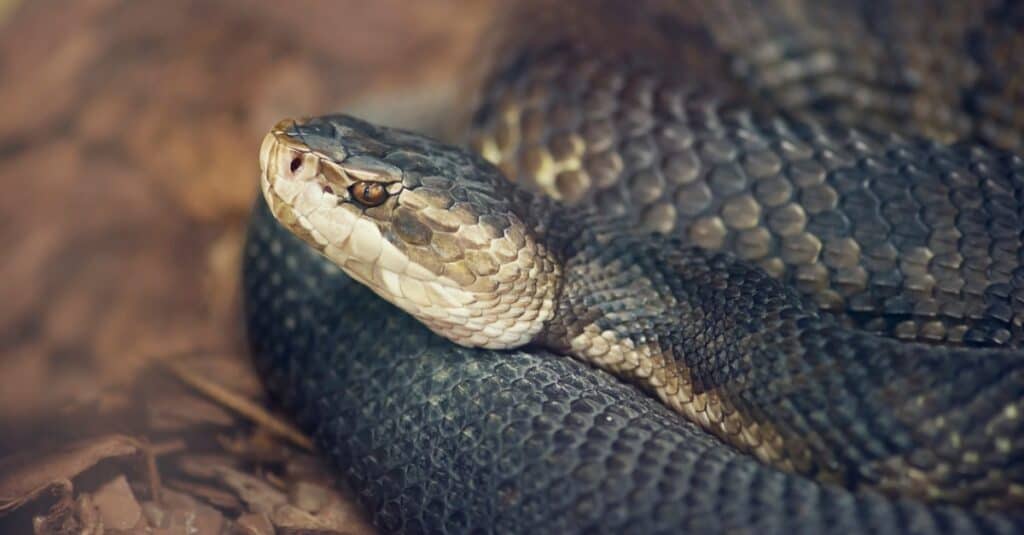
Cottonmouths eat fish, rodents, shrews, frogs, reptiles, birds, insects, and eggs.
©iStock.com/Saddako
A final difference between cottonmouths and rattlesnakes is their diet and hunting style. While both of these snakes inject their prey with a powerful and immobilizing venom, cottonmouths eat a wider variety of things compared to rattlesnakes. For example, rattlesnakes eat rats, mice, lizards, frogs, squirrels, and rabbits, while cottonmouths eat fish, rodents, shrews, frogs, reptiles, birds, insects, and eggs.
Summary of Cottonmouth vs. Rattlesnake
Here’s a recap of the five key differences between these two snake species.
| Number | Category | Difference |
|---|---|---|
| 1 | Size and Weight | Cottonmouths are smaller than the average rattlesnake, but it depends on the specific breed or rattlesnake species. |
| 2 | Location and Habitat Preferences | Cottonmouths are only found in North America, while rattlesnakes are found in North, South, and Central America. Cottonmouths enjoy living in watery or aquatic environments, while rattlesnakes prefer spending their time on land, and in warm, dry climates. |
| 3 | Appearance | Rattlesnakes have a distinct diamond pattern on their bodies and are found in more colors than cottonmouths. Cottonmouths can be identified by their bright white mouths. Rattlesnakes have rattles on the end of their tails. |
| 4 | Behavior | If cornered or threatened, rattlesnakes rattle their tails and coil up, while cottonmouths mimic a rattlesnake’s rattle and emit a musk to deter predators. |
| 5 | Diet | Cottonmouths eat a wider variety of foods than rattlesnakes. |
How Do You Keep Snakes Away?
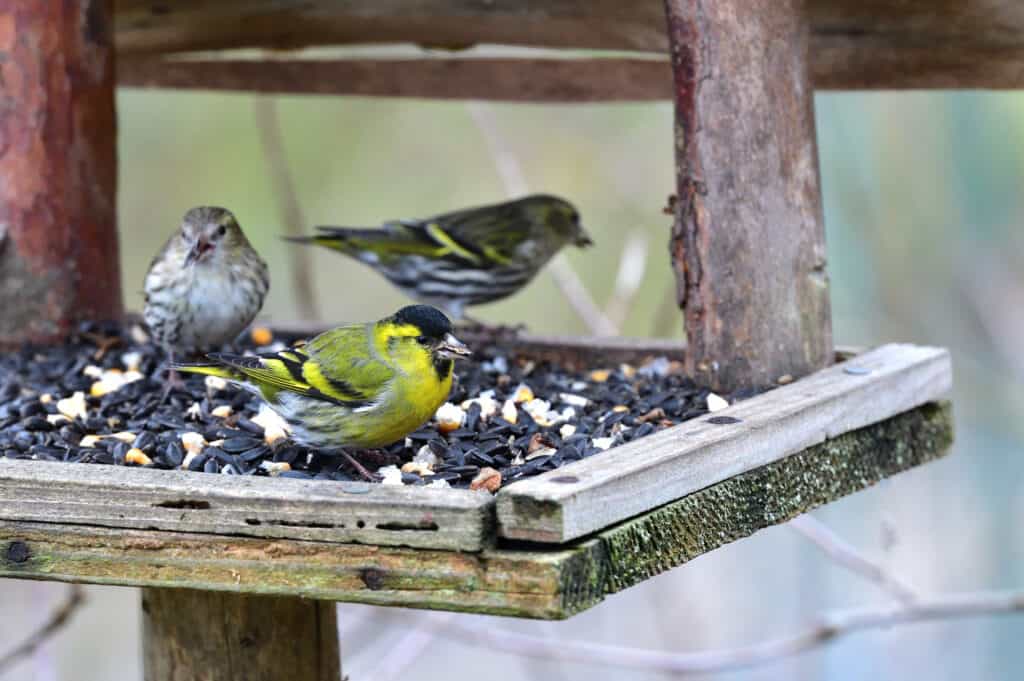
Bird feeders can attract many varieties of beautiful birds to one’s yard, but can also attract other animals like rodents and snakes.
©Klimek Pavol/Shutterstock.com
While snakes in the wild serve a valuable purpose by keeping down rodent populations, some people are just unable to see the good in these slithering serpents. You especially would not want one slipping into your home unannounced! So what are some ways to keep snakes outside where they belong, and preferably, out of your yard as well?
Below are 10 simple steps you can take to help keep the snake population down in and around your home:
- Sealing Up Cracks–You’ll need to search the perimeter of your home for access points, warm or damp crawl spaces, or holes in your home’s foundation or near ground level. Storm drains are also attractive to snakes. Sealing these entry points appropriately is a start to keeping snakes out.
- Removing Potential Food Sources–You may not have realized that bird feeders are potential problems, as they not only attract birds but also rodents and insects, both of which attract snakes. Outdoor pet food can have the same effect. If possible, feed your pets indoors and keep any outdoor seed or other foods in sealed containers.
- Removing Standing Water–Standing water can attract frogs, lizards, small mammals, and snakes. Try to reduce standing water as much as possible, even if it means watering your lawn less.
- Trapping the Snake–If there are just a few pesky snakes troubling you, you can purchase professionally-made snake traps at your local hardware store and try to snag them. Rather than killing them, consider transporting the snakes about 6 miles away and freeing them in the wild.
- Building Strong Fences–There are special types of fences that can keep snakes out, usually made of vinyl or tight wire mesh. Consulting your local hardware store for advice can help with this strategy.
- Employing Proper Landscaping and Maintenance–Snakes are drawn to areas of overgrown vegetation, loose debris, wood piles, or other areas where they can hide. Keeping your yard maintained regularly can help cut down on places for snakes to hang out.
- Bringing in Domesticated Fowl–This may be an extreme solution, but domestic fowl like chickens are capable of managing snake populations, especially roosters, who protect hens and chicks from danger.
- Luring Birds of Prey–Growing tall trees with strong branches can be a way to attract birds of prey like owls, who like to prey on snakes. Another idea would be to build a nesting box to make them feel at home.
- Calling Wildlife Control–When all else fails, there’s always the option of calling a professional to come remove an unwanted snake from your property. Exterminators are also valuable, as they can help rid your house of rodents, which attract snakes.
- Removing Debris and Keeping Woodpiles Off the Ground–This one is similar to #6, but focuses on woodpiles, which should not be left sitting on the ground if you want to keep snakes away. Elevating them will help deter snakes, as well as remove empty containers and piles of debris where snakes may gather.
The photo featured at the top of this post is ©
Discover the "Monster" Snake 5X Bigger than an Anaconda
Every day A-Z Animals sends out some of the most incredible facts in the world from our free newsletter. Want to discover the 10 most beautiful snakes in the world, a "snake island" where you're never more than 3 feet from danger, or a "monster" snake 5X larger than an anaconda? Then sign up right now and you'll start receiving our daily newsletter absolutely free.
Thank you for reading! Have some feedback for us? Contact the AZ Animals editorial team.







